Assessing Environmental Policies: A Niger Delta, Nigeria Study
VerifiedAdded on 2023/04/19
|17
|3611
|390
AI Summary
This research proposal aims to evaluate the effectiveness of Nigerian government environmental policies in protecting the Niger Delta, focusing on the impact of oil extraction. The proposal outlines the significance of the study, research aims and objectives, and key research questions. It includes a literature review that examines the development of Nigeria's environmental regulatory framework, highlighting challenges such as overlapping authorities and inadequate environmental information. The proposed methodology adopts a positivism philosophy with an inductive research approach, employing case studies, action-oriented research, quantitative surveys, and qualitative interviews. The proposal also addresses ethical considerations, potential limitations, and provides a timeline for the study. This document, contributed by a student and available on Desklib, offers valuable insights into environmental policy evaluation and research methodologies.

1
Research proposal
Evaluating the Nigerian Government Environmental Policies for Protecting the Niger Delta
Student Name
Course Name
Professor’s Name
School
The City and State where it is located
Date
Research proposal
Evaluating the Nigerian Government Environmental Policies for Protecting the Niger Delta
Student Name
Course Name
Professor’s Name
School
The City and State where it is located
Date
Paraphrase This Document
Need a fresh take? Get an instant paraphrase of this document with our AI Paraphraser

2
TABLE OF CONTENTS
1. Introduction............................................................................................................................4
1.1. Introduction to the study topic......................................................................................4
1.2. Significance of the study.................................................................................................5
1.3. Research aims..................................................................................................................5
1.4. Objectives of the proposal..............................................................................................5
1.5. Research question...........................................................................................................6
2. Literature review....................................................................................................................6
2.1. The development of environmental regulatory framework and policies in Nigeria.6
2.2. Challenges facing the Nigerian strategies on environmental policies........................8
3. Methodology............................................................................................................................9
3.1. Research philosophy.......................................................................................................9
3.2. Research approach........................................................................................................10
3.3. Research strategy..........................................................................................................11
3.4. Time horizon..................................................................................................................12
3.5. Data collection method.................................................................................................12
3.6. Data analysis..................................................................................................................12
3.7. The timeline regarding the study.................................................................................13
3.8. Research limitations......................................................................................................14
3.9. Ethical aspects...............................................................................................................14
TABLE OF CONTENTS
1. Introduction............................................................................................................................4
1.1. Introduction to the study topic......................................................................................4
1.2. Significance of the study.................................................................................................5
1.3. Research aims..................................................................................................................5
1.4. Objectives of the proposal..............................................................................................5
1.5. Research question...........................................................................................................6
2. Literature review....................................................................................................................6
2.1. The development of environmental regulatory framework and policies in Nigeria.6
2.2. Challenges facing the Nigerian strategies on environmental policies........................8
3. Methodology............................................................................................................................9
3.1. Research philosophy.......................................................................................................9
3.2. Research approach........................................................................................................10
3.3. Research strategy..........................................................................................................11
3.4. Time horizon..................................................................................................................12
3.5. Data collection method.................................................................................................12
3.6. Data analysis..................................................................................................................12
3.7. The timeline regarding the study.................................................................................13
3.8. Research limitations......................................................................................................14
3.9. Ethical aspects...............................................................................................................14

3
References.....................................................................................................................................15
References.....................................................................................................................................15
⊘ This is a preview!⊘
Do you want full access?
Subscribe today to unlock all pages.

Trusted by 1+ million students worldwide

4
1. Introduction
1.1. Introduction to the study topic
Environmental conservation has been the focus by the states and the governments across
the world (Ringquist, 2016). However, the balance between sustaining the economic activities
that could lead to pollution has been a challenge as these activities such as mining that drives the
economy of the relevant countries are usually prone to contaminating the surrounding. The
different environmental bodies have called upon each country to spearhead the conservation
agenda for the future generations through implementations of strategic policies that champion for
the protection of the environment (Sachs, 2015). Therefore, this research proposal is based on an
evaluation of the environmental policies put in place by the Nigerian government on protecting
the Niger Delta based on the case study of oil extraction and environmental issues in the Niger
Delta. It is worth knowing that every mention of the environmental aspects in Nigeria, the gas
and oil industry comes in mind since these products are reported to account for roughly 90 per
cent of the countries revenue. This implies that the extraction of oil and gas, which is
approximated to be two million barrels every day, cannot be foregone as the major economic
activity for the Nigerian demographics.
With this significant knowledge in mind, it brings attention to the importance of
formulating and evaluating the necessary environmental policies that would promote oil and gas
extraction for economic gains as well as providing the means and measures that would protect
the environment. Additionally, with the Delta region being densely populated, it puts many lives
at risk due to the long-term effects of air pollutants as well as the destruction of the aquatic lives
as pointed out by (Meena et al., 2018, pp.1-15). The oil and gas industry is critical to the health
1. Introduction
1.1. Introduction to the study topic
Environmental conservation has been the focus by the states and the governments across
the world (Ringquist, 2016). However, the balance between sustaining the economic activities
that could lead to pollution has been a challenge as these activities such as mining that drives the
economy of the relevant countries are usually prone to contaminating the surrounding. The
different environmental bodies have called upon each country to spearhead the conservation
agenda for the future generations through implementations of strategic policies that champion for
the protection of the environment (Sachs, 2015). Therefore, this research proposal is based on an
evaluation of the environmental policies put in place by the Nigerian government on protecting
the Niger Delta based on the case study of oil extraction and environmental issues in the Niger
Delta. It is worth knowing that every mention of the environmental aspects in Nigeria, the gas
and oil industry comes in mind since these products are reported to account for roughly 90 per
cent of the countries revenue. This implies that the extraction of oil and gas, which is
approximated to be two million barrels every day, cannot be foregone as the major economic
activity for the Nigerian demographics.
With this significant knowledge in mind, it brings attention to the importance of
formulating and evaluating the necessary environmental policies that would promote oil and gas
extraction for economic gains as well as providing the means and measures that would protect
the environment. Additionally, with the Delta region being densely populated, it puts many lives
at risk due to the long-term effects of air pollutants as well as the destruction of the aquatic lives
as pointed out by (Meena et al., 2018, pp.1-15). The oil and gas industry is critical to the health
Paraphrase This Document
Need a fresh take? Get an instant paraphrase of this document with our AI Paraphraser
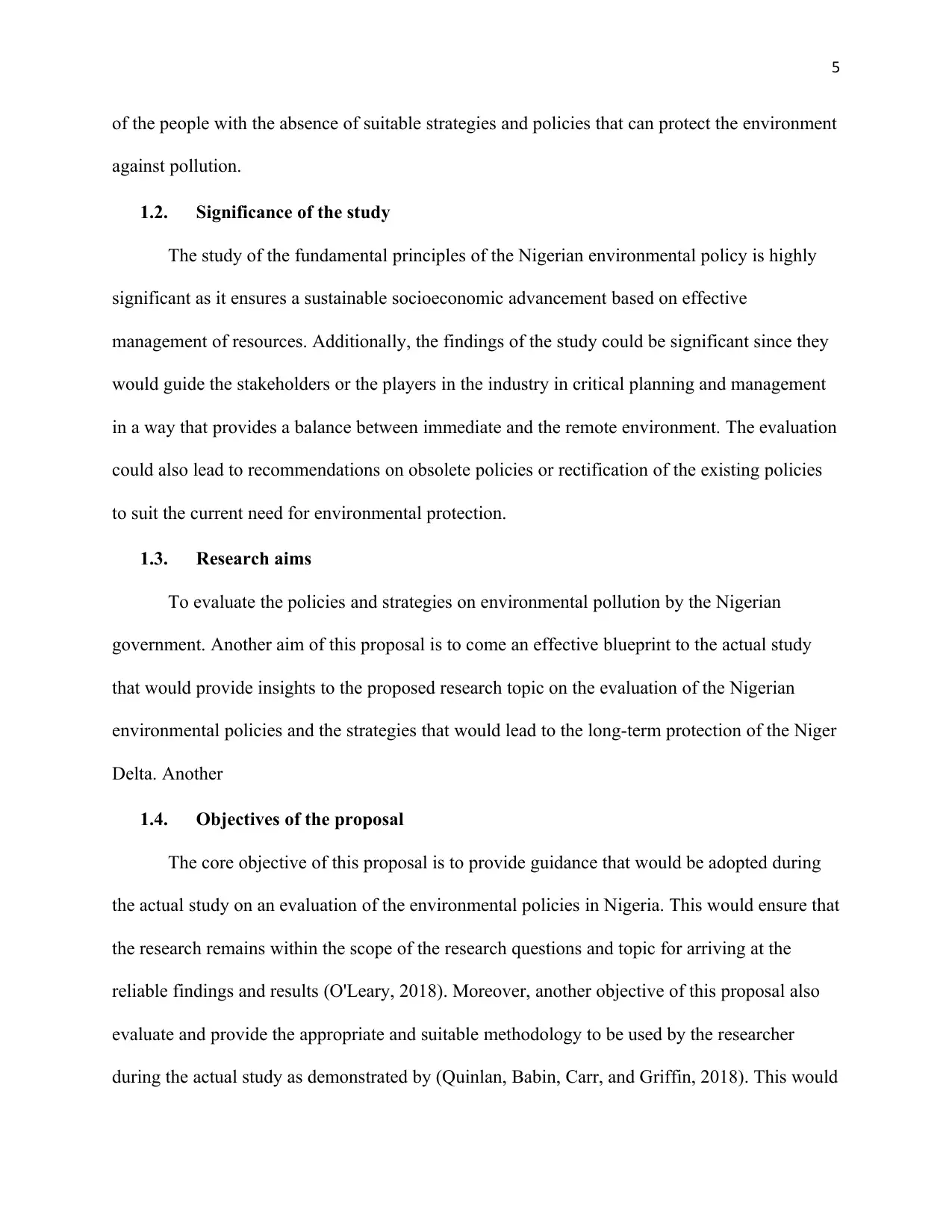
5
of the people with the absence of suitable strategies and policies that can protect the environment
against pollution.
1.2. Significance of the study
The study of the fundamental principles of the Nigerian environmental policy is highly
significant as it ensures a sustainable socioeconomic advancement based on effective
management of resources. Additionally, the findings of the study could be significant since they
would guide the stakeholders or the players in the industry in critical planning and management
in a way that provides a balance between immediate and the remote environment. The evaluation
could also lead to recommendations on obsolete policies or rectification of the existing policies
to suit the current need for environmental protection.
1.3. Research aims
To evaluate the policies and strategies on environmental pollution by the Nigerian
government. Another aim of this proposal is to come an effective blueprint to the actual study
that would provide insights to the proposed research topic on the evaluation of the Nigerian
environmental policies and the strategies that would lead to the long-term protection of the Niger
Delta. Another
1.4. Objectives of the proposal
The core objective of this proposal is to provide guidance that would be adopted during
the actual study on an evaluation of the environmental policies in Nigeria. This would ensure that
the research remains within the scope of the research questions and topic for arriving at the
reliable findings and results (O'Leary, 2018). Moreover, another objective of this proposal also
evaluate and provide the appropriate and suitable methodology to be used by the researcher
during the actual study as demonstrated by (Quinlan, Babin, Carr, and Griffin, 2018). This would
of the people with the absence of suitable strategies and policies that can protect the environment
against pollution.
1.2. Significance of the study
The study of the fundamental principles of the Nigerian environmental policy is highly
significant as it ensures a sustainable socioeconomic advancement based on effective
management of resources. Additionally, the findings of the study could be significant since they
would guide the stakeholders or the players in the industry in critical planning and management
in a way that provides a balance between immediate and the remote environment. The evaluation
could also lead to recommendations on obsolete policies or rectification of the existing policies
to suit the current need for environmental protection.
1.3. Research aims
To evaluate the policies and strategies on environmental pollution by the Nigerian
government. Another aim of this proposal is to come an effective blueprint to the actual study
that would provide insights to the proposed research topic on the evaluation of the Nigerian
environmental policies and the strategies that would lead to the long-term protection of the Niger
Delta. Another
1.4. Objectives of the proposal
The core objective of this proposal is to provide guidance that would be adopted during
the actual study on an evaluation of the environmental policies in Nigeria. This would ensure that
the research remains within the scope of the research questions and topic for arriving at the
reliable findings and results (O'Leary, 2018). Moreover, another objective of this proposal also
evaluate and provide the appropriate and suitable methodology to be used by the researcher
during the actual study as demonstrated by (Quinlan, Babin, Carr, and Griffin, 2018). This would
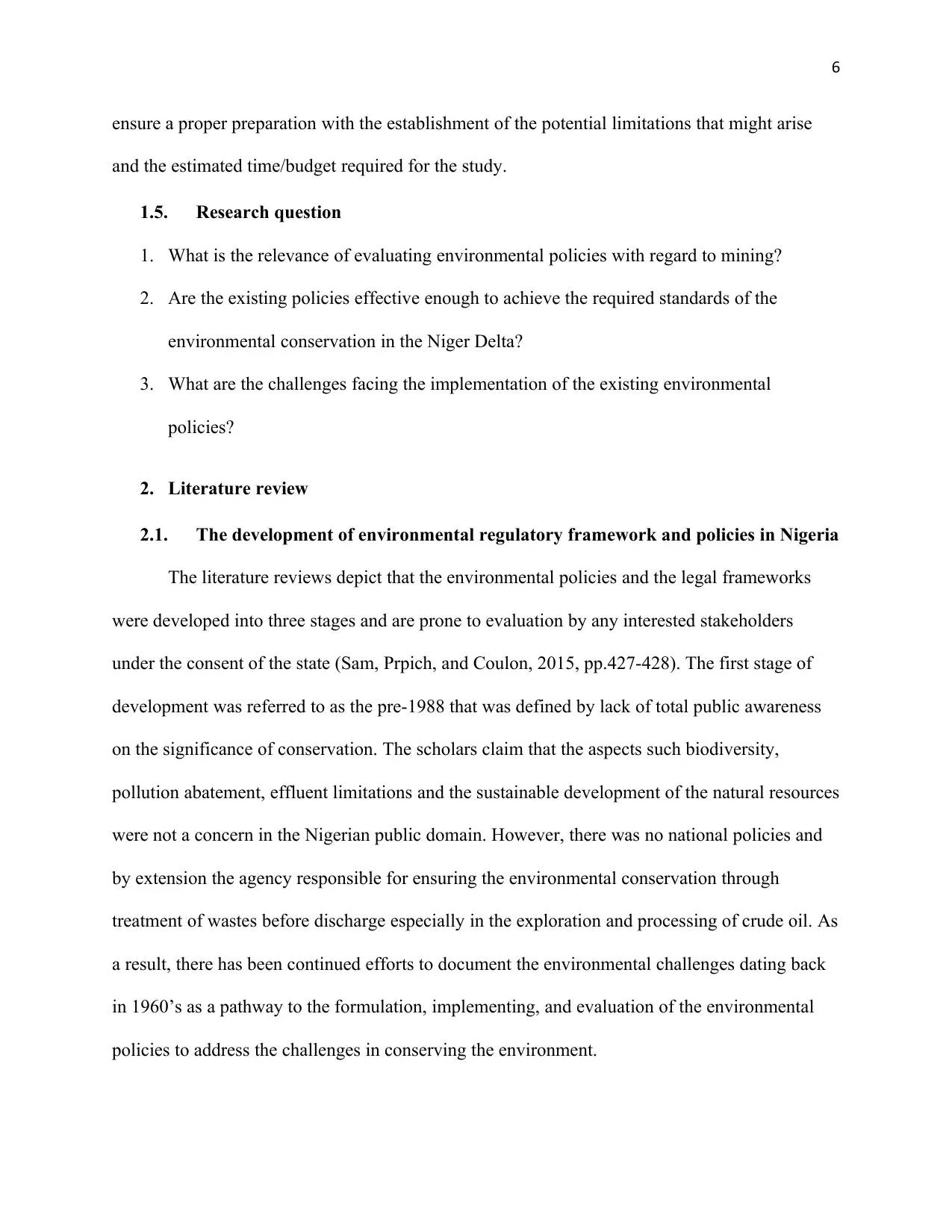
6
ensure a proper preparation with the establishment of the potential limitations that might arise
and the estimated time/budget required for the study.
1.5. Research question
1. What is the relevance of evaluating environmental policies with regard to mining?
2. Are the existing policies effective enough to achieve the required standards of the
environmental conservation in the Niger Delta?
3. What are the challenges facing the implementation of the existing environmental
policies?
2. Literature review
2.1. The development of environmental regulatory framework and policies in Nigeria
The literature reviews depict that the environmental policies and the legal frameworks
were developed into three stages and are prone to evaluation by any interested stakeholders
under the consent of the state (Sam, Prpich, and Coulon, 2015, pp.427-428). The first stage of
development was referred to as the pre-1988 that was defined by lack of total public awareness
on the significance of conservation. The scholars claim that the aspects such biodiversity,
pollution abatement, effluent limitations and the sustainable development of the natural resources
were not a concern in the Nigerian public domain. However, there was no national policies and
by extension the agency responsible for ensuring the environmental conservation through
treatment of wastes before discharge especially in the exploration and processing of crude oil. As
a result, there has been continued efforts to document the environmental challenges dating back
in 1960’s as a pathway to the formulation, implementing, and evaluation of the environmental
policies to address the challenges in conserving the environment.
ensure a proper preparation with the establishment of the potential limitations that might arise
and the estimated time/budget required for the study.
1.5. Research question
1. What is the relevance of evaluating environmental policies with regard to mining?
2. Are the existing policies effective enough to achieve the required standards of the
environmental conservation in the Niger Delta?
3. What are the challenges facing the implementation of the existing environmental
policies?
2. Literature review
2.1. The development of environmental regulatory framework and policies in Nigeria
The literature reviews depict that the environmental policies and the legal frameworks
were developed into three stages and are prone to evaluation by any interested stakeholders
under the consent of the state (Sam, Prpich, and Coulon, 2015, pp.427-428). The first stage of
development was referred to as the pre-1988 that was defined by lack of total public awareness
on the significance of conservation. The scholars claim that the aspects such biodiversity,
pollution abatement, effluent limitations and the sustainable development of the natural resources
were not a concern in the Nigerian public domain. However, there was no national policies and
by extension the agency responsible for ensuring the environmental conservation through
treatment of wastes before discharge especially in the exploration and processing of crude oil. As
a result, there has been continued efforts to document the environmental challenges dating back
in 1960’s as a pathway to the formulation, implementing, and evaluation of the environmental
policies to address the challenges in conserving the environment.
⊘ This is a preview!⊘
Do you want full access?
Subscribe today to unlock all pages.

Trusted by 1+ million students worldwide

7
The pathway for the formulation of the policies led to the formation of the Petroleum Act
1969 that entails the regulations of controlling pollution in the mining operations to protect the
watercourse and the atmosphere. Additionally, the other regulations provided by the Petroleum
Act include the Drilling and Production Regulations 1969, The Mineral Oils Safety Regulation
1963, The Petroleum Regulations 1967, and the Petroleum Refining Regulations 1974. (Sam,
coulon, and Prpich, 2016, pp.916-925) The objectives of these regulatory standards were to
establish the guidelines for quality control in the petroleum industry concerning planned
monitoring of environmental conservation, to come up with an integrated volume and materials
on pollution abatement technologies for the industry, and to standardize the abatement of
pollution and evaluation procedures for various parameters.
The second generation of the regulatory frameworks precedes the establishment of the
Federal Environmental Protection Agency in 1988 due to the emerging of the global
environmental policies and strategies. The principle had provisions that declared commitment of
the country to the policies that could uphold sustainable development basing on the effective
management of the environments. The policies dictated that the environmental aspects be
integrated into economic decision-making processes, employment of economic instruments in
managing the natural resources, and application of environmental friendly technologies. The
policy further required that assessment of the impacts on the environment be carried out before
implementation of any major project.
The third generation is the expected adjustments in the existing regulation through
implementing the Local Content Act or the Petroleum Industry Bill (Adedeji et al., 2016, pp.61-
73). The Act entails the promotion of local skills through technology transfer, local
manufacturing and the use of local labour in the manufacturing industry. The objective of the
The pathway for the formulation of the policies led to the formation of the Petroleum Act
1969 that entails the regulations of controlling pollution in the mining operations to protect the
watercourse and the atmosphere. Additionally, the other regulations provided by the Petroleum
Act include the Drilling and Production Regulations 1969, The Mineral Oils Safety Regulation
1963, The Petroleum Regulations 1967, and the Petroleum Refining Regulations 1974. (Sam,
coulon, and Prpich, 2016, pp.916-925) The objectives of these regulatory standards were to
establish the guidelines for quality control in the petroleum industry concerning planned
monitoring of environmental conservation, to come up with an integrated volume and materials
on pollution abatement technologies for the industry, and to standardize the abatement of
pollution and evaluation procedures for various parameters.
The second generation of the regulatory frameworks precedes the establishment of the
Federal Environmental Protection Agency in 1988 due to the emerging of the global
environmental policies and strategies. The principle had provisions that declared commitment of
the country to the policies that could uphold sustainable development basing on the effective
management of the environments. The policies dictated that the environmental aspects be
integrated into economic decision-making processes, employment of economic instruments in
managing the natural resources, and application of environmental friendly technologies. The
policy further required that assessment of the impacts on the environment be carried out before
implementation of any major project.
The third generation is the expected adjustments in the existing regulation through
implementing the Local Content Act or the Petroleum Industry Bill (Adedeji et al., 2016, pp.61-
73). The Act entails the promotion of local skills through technology transfer, local
manufacturing and the use of local labour in the manufacturing industry. The objective of the
Paraphrase This Document
Need a fresh take? Get an instant paraphrase of this document with our AI Paraphraser

8
Nigerian government through this Act is to increase the involvement and the participation of the
citizens in the mining industry that would benefit the Nigerians through the private companies
thus contributing to the economic growth (Sidique, Rahman, and Hook, 2015, pp.425-437).
Additionally, the scholars claim that the move to increase the local participation in the industry
would bring to the attention of the local people and desire to conserve the environment for the
future generations.
Moreover, the local Act facilitated the review of the Environmental Impact Assessment
(EIA) of 1992 among other instruments that aim at implementing suitable policies in all the
states and the local authorities and encouraging the innovation of procedure for the exchange of
information across the environmental conservation agencies thus facilitating collaboration and
effectiveness. The scholars ascertain that the EIA Act 1992 was the first legislative piece that led
to the administration of inconvertible policies for the socioeconomic activities including the gas
and oil sector (Nzeadibe et al., 2015, pp.74-83). Additionally, the Act has aided in creating the
level of awareness among all the stakeholders on environmental strategies and policies as well as
creating a sound regulatory framework for ensuring all the projects conform to the conservation
policies.
2.2. Challenges facing the Nigerian strategies on environmental policies
Some scholars have single out the overlap of authorities as one of the major setbacks
facing the implementation of the environmental policies and strategies (Elenwo, Ikechukwu, and
Akankali, 2014, p.884). It has been pointed out that the conflicts between the federal/local
government and the ministries/agencies such as the NAFDAC versus FEPA over their
responsibilities in environmental conservation is a great challenge to implementation of the
policies for effective outcomes. Moreover, the duplication of the policies among different
Nigerian government through this Act is to increase the involvement and the participation of the
citizens in the mining industry that would benefit the Nigerians through the private companies
thus contributing to the economic growth (Sidique, Rahman, and Hook, 2015, pp.425-437).
Additionally, the scholars claim that the move to increase the local participation in the industry
would bring to the attention of the local people and desire to conserve the environment for the
future generations.
Moreover, the local Act facilitated the review of the Environmental Impact Assessment
(EIA) of 1992 among other instruments that aim at implementing suitable policies in all the
states and the local authorities and encouraging the innovation of procedure for the exchange of
information across the environmental conservation agencies thus facilitating collaboration and
effectiveness. The scholars ascertain that the EIA Act 1992 was the first legislative piece that led
to the administration of inconvertible policies for the socioeconomic activities including the gas
and oil sector (Nzeadibe et al., 2015, pp.74-83). Additionally, the Act has aided in creating the
level of awareness among all the stakeholders on environmental strategies and policies as well as
creating a sound regulatory framework for ensuring all the projects conform to the conservation
policies.
2.2. Challenges facing the Nigerian strategies on environmental policies
Some scholars have single out the overlap of authorities as one of the major setbacks
facing the implementation of the environmental policies and strategies (Elenwo, Ikechukwu, and
Akankali, 2014, p.884). It has been pointed out that the conflicts between the federal/local
government and the ministries/agencies such as the NAFDAC versus FEPA over their
responsibilities in environmental conservation is a great challenge to implementation of the
policies for effective outcomes. Moreover, the duplication of the policies among different
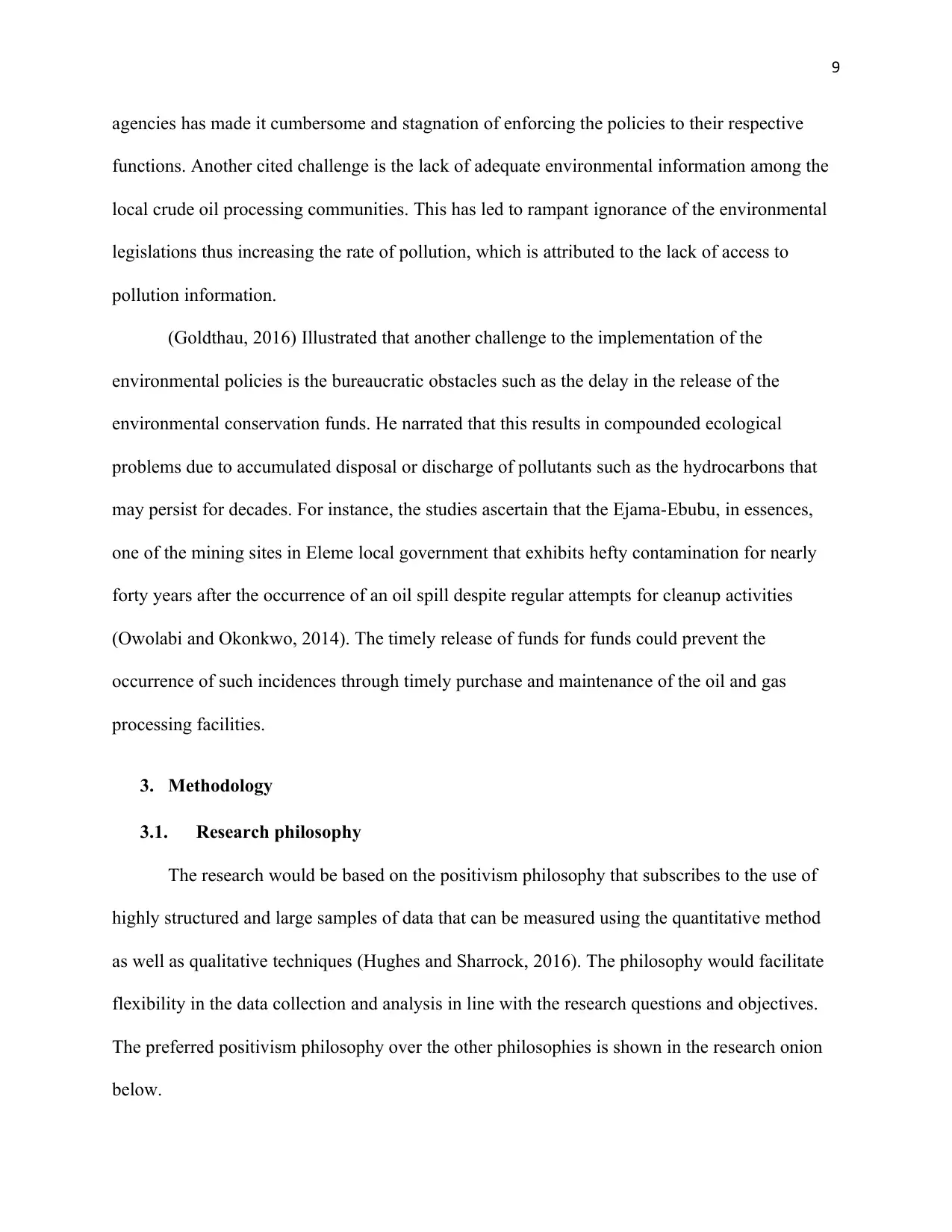
9
agencies has made it cumbersome and stagnation of enforcing the policies to their respective
functions. Another cited challenge is the lack of adequate environmental information among the
local crude oil processing communities. This has led to rampant ignorance of the environmental
legislations thus increasing the rate of pollution, which is attributed to the lack of access to
pollution information.
(Goldthau, 2016) Illustrated that another challenge to the implementation of the
environmental policies is the bureaucratic obstacles such as the delay in the release of the
environmental conservation funds. He narrated that this results in compounded ecological
problems due to accumulated disposal or discharge of pollutants such as the hydrocarbons that
may persist for decades. For instance, the studies ascertain that the Ejama-Ebubu, in essences,
one of the mining sites in Eleme local government that exhibits hefty contamination for nearly
forty years after the occurrence of an oil spill despite regular attempts for cleanup activities
(Owolabi and Okonkwo, 2014). The timely release of funds for funds could prevent the
occurrence of such incidences through timely purchase and maintenance of the oil and gas
processing facilities.
3. Methodology
3.1. Research philosophy
The research would be based on the positivism philosophy that subscribes to the use of
highly structured and large samples of data that can be measured using the quantitative method
as well as qualitative techniques (Hughes and Sharrock, 2016). The philosophy would facilitate
flexibility in the data collection and analysis in line with the research questions and objectives.
The preferred positivism philosophy over the other philosophies is shown in the research onion
below.
agencies has made it cumbersome and stagnation of enforcing the policies to their respective
functions. Another cited challenge is the lack of adequate environmental information among the
local crude oil processing communities. This has led to rampant ignorance of the environmental
legislations thus increasing the rate of pollution, which is attributed to the lack of access to
pollution information.
(Goldthau, 2016) Illustrated that another challenge to the implementation of the
environmental policies is the bureaucratic obstacles such as the delay in the release of the
environmental conservation funds. He narrated that this results in compounded ecological
problems due to accumulated disposal or discharge of pollutants such as the hydrocarbons that
may persist for decades. For instance, the studies ascertain that the Ejama-Ebubu, in essences,
one of the mining sites in Eleme local government that exhibits hefty contamination for nearly
forty years after the occurrence of an oil spill despite regular attempts for cleanup activities
(Owolabi and Okonkwo, 2014). The timely release of funds for funds could prevent the
occurrence of such incidences through timely purchase and maintenance of the oil and gas
processing facilities.
3. Methodology
3.1. Research philosophy
The research would be based on the positivism philosophy that subscribes to the use of
highly structured and large samples of data that can be measured using the quantitative method
as well as qualitative techniques (Hughes and Sharrock, 2016). The philosophy would facilitate
flexibility in the data collection and analysis in line with the research questions and objectives.
The preferred positivism philosophy over the other philosophies is shown in the research onion
below.
⊘ This is a preview!⊘
Do you want full access?
Subscribe today to unlock all pages.

Trusted by 1+ million students worldwide

10
3.2. Research approach
The inductive research approach would be deployed which is also known as inductive
reasoning that starts with an observation to come up with the theories that would be applied
during the research process. The approach involves the search for the relevant pattern in the
study through observations and then develop explanations from these observations through a
number of hypotheses as acknowledged by (Woiceshyn and Daellenbach, 2018, pp.183-195).
For instance, during the evaluation of a highlighted policy, the approach would enable the
research to alter the direction of the research process in case the defined scope does not lead to
answering the research questions and objectives.
3.2. Research approach
The inductive research approach would be deployed which is also known as inductive
reasoning that starts with an observation to come up with the theories that would be applied
during the research process. The approach involves the search for the relevant pattern in the
study through observations and then develop explanations from these observations through a
number of hypotheses as acknowledged by (Woiceshyn and Daellenbach, 2018, pp.183-195).
For instance, during the evaluation of a highlighted policy, the approach would enable the
research to alter the direction of the research process in case the defined scope does not lead to
answering the research questions and objectives.
Paraphrase This Document
Need a fresh take? Get an instant paraphrase of this document with our AI Paraphraser
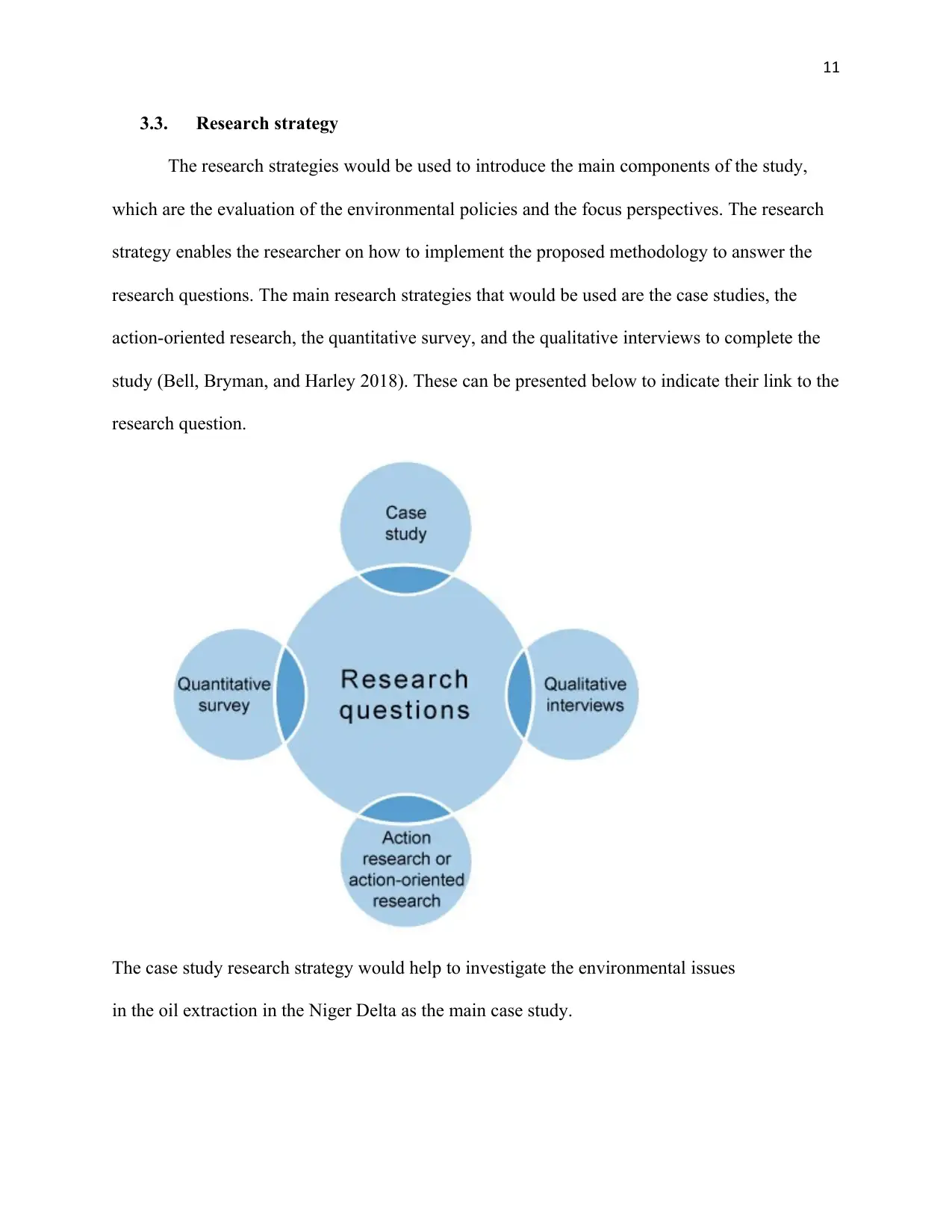
11
3.3. Research strategy
The research strategies would be used to introduce the main components of the study,
which are the evaluation of the environmental policies and the focus perspectives. The research
strategy enables the researcher on how to implement the proposed methodology to answer the
research questions. The main research strategies that would be used are the case studies, the
action-oriented research, the quantitative survey, and the qualitative interviews to complete the
study (Bell, Bryman, and Harley 2018). These can be presented below to indicate their link to the
research question.
The case study research strategy would help to investigate the environmental issues
in the oil extraction in the Niger Delta as the main case study.
3.3. Research strategy
The research strategies would be used to introduce the main components of the study,
which are the evaluation of the environmental policies and the focus perspectives. The research
strategy enables the researcher on how to implement the proposed methodology to answer the
research questions. The main research strategies that would be used are the case studies, the
action-oriented research, the quantitative survey, and the qualitative interviews to complete the
study (Bell, Bryman, and Harley 2018). These can be presented below to indicate their link to the
research question.
The case study research strategy would help to investigate the environmental issues
in the oil extraction in the Niger Delta as the main case study.
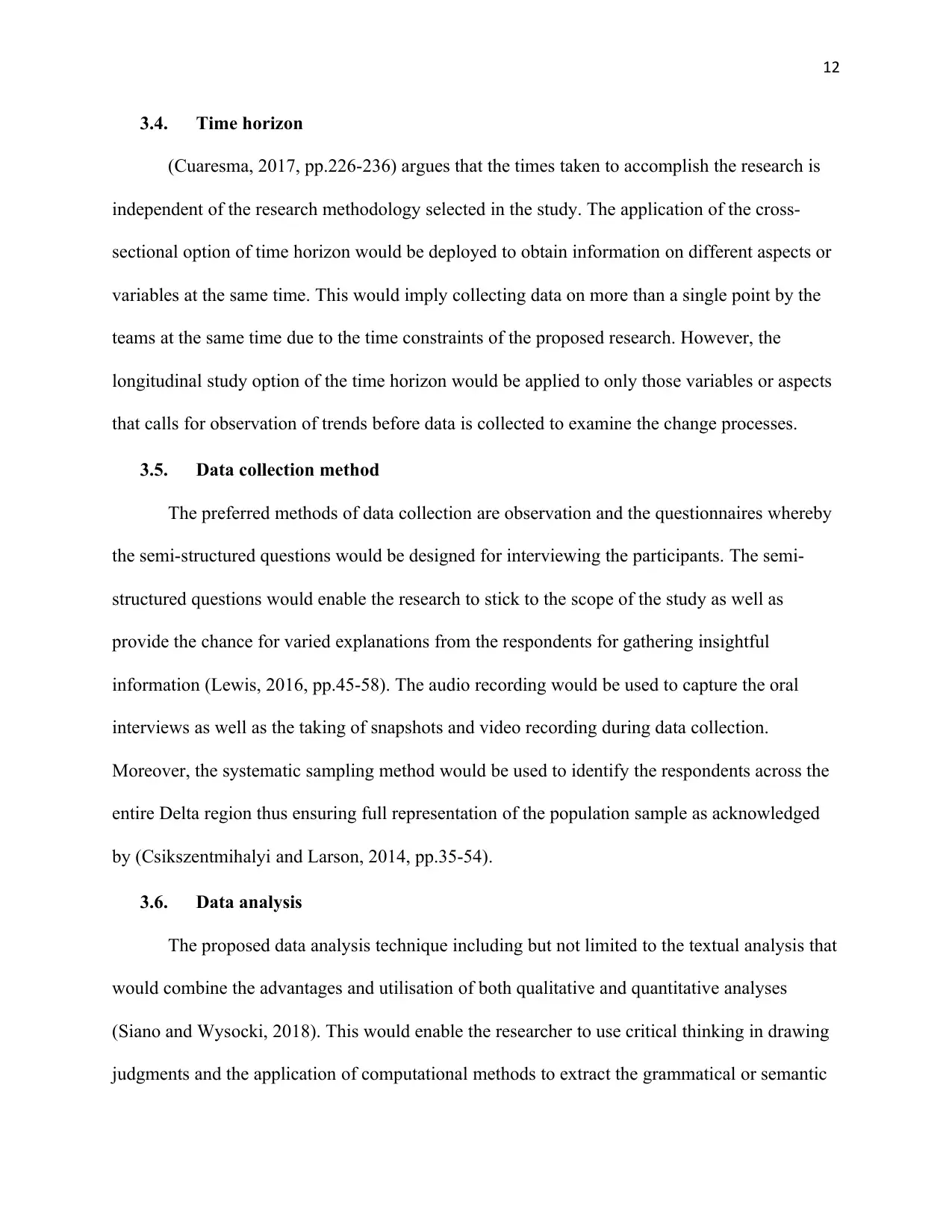
12
3.4. Time horizon
(Cuaresma, 2017, pp.226-236) argues that the times taken to accomplish the research is
independent of the research methodology selected in the study. The application of the cross-
sectional option of time horizon would be deployed to obtain information on different aspects or
variables at the same time. This would imply collecting data on more than a single point by the
teams at the same time due to the time constraints of the proposed research. However, the
longitudinal study option of the time horizon would be applied to only those variables or aspects
that calls for observation of trends before data is collected to examine the change processes.
3.5. Data collection method
The preferred methods of data collection are observation and the questionnaires whereby
the semi-structured questions would be designed for interviewing the participants. The semi-
structured questions would enable the research to stick to the scope of the study as well as
provide the chance for varied explanations from the respondents for gathering insightful
information (Lewis, 2016, pp.45-58). The audio recording would be used to capture the oral
interviews as well as the taking of snapshots and video recording during data collection.
Moreover, the systematic sampling method would be used to identify the respondents across the
entire Delta region thus ensuring full representation of the population sample as acknowledged
by (Csikszentmihalyi and Larson, 2014, pp.35-54).
3.6. Data analysis
The proposed data analysis technique including but not limited to the textual analysis that
would combine the advantages and utilisation of both qualitative and quantitative analyses
(Siano and Wysocki, 2018). This would enable the researcher to use critical thinking in drawing
judgments and the application of computational methods to extract the grammatical or semantic
3.4. Time horizon
(Cuaresma, 2017, pp.226-236) argues that the times taken to accomplish the research is
independent of the research methodology selected in the study. The application of the cross-
sectional option of time horizon would be deployed to obtain information on different aspects or
variables at the same time. This would imply collecting data on more than a single point by the
teams at the same time due to the time constraints of the proposed research. However, the
longitudinal study option of the time horizon would be applied to only those variables or aspects
that calls for observation of trends before data is collected to examine the change processes.
3.5. Data collection method
The preferred methods of data collection are observation and the questionnaires whereby
the semi-structured questions would be designed for interviewing the participants. The semi-
structured questions would enable the research to stick to the scope of the study as well as
provide the chance for varied explanations from the respondents for gathering insightful
information (Lewis, 2016, pp.45-58). The audio recording would be used to capture the oral
interviews as well as the taking of snapshots and video recording during data collection.
Moreover, the systematic sampling method would be used to identify the respondents across the
entire Delta region thus ensuring full representation of the population sample as acknowledged
by (Csikszentmihalyi and Larson, 2014, pp.35-54).
3.6. Data analysis
The proposed data analysis technique including but not limited to the textual analysis that
would combine the advantages and utilisation of both qualitative and quantitative analyses
(Siano and Wysocki, 2018). This would enable the researcher to use critical thinking in drawing
judgments and the application of computational methods to extract the grammatical or semantic
⊘ This is a preview!⊘
Do you want full access?
Subscribe today to unlock all pages.

Trusted by 1+ million students worldwide
1 out of 17
Related Documents
Your All-in-One AI-Powered Toolkit for Academic Success.
+13062052269
info@desklib.com
Available 24*7 on WhatsApp / Email
![[object Object]](/_next/static/media/star-bottom.7253800d.svg)
Unlock your academic potential
Copyright © 2020–2025 A2Z Services. All Rights Reserved. Developed and managed by ZUCOL.





